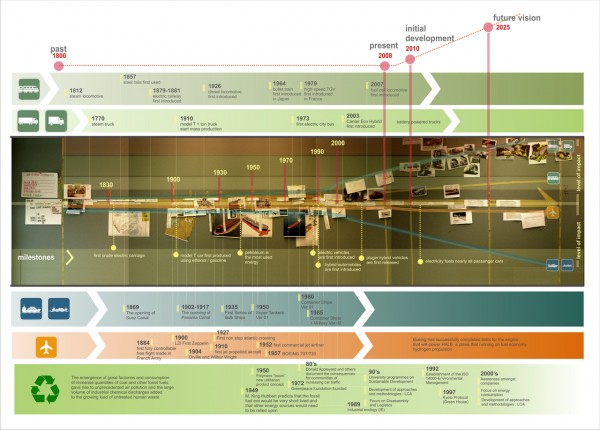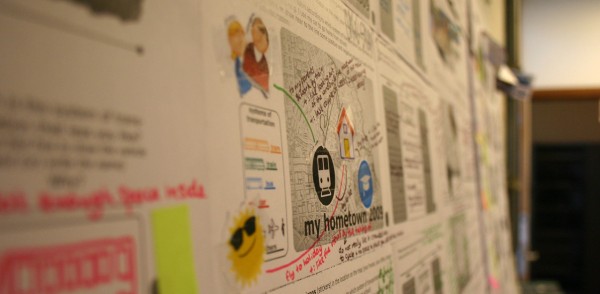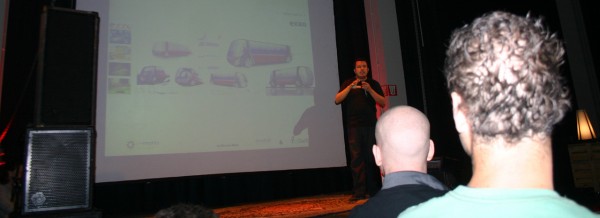Blog
I.T.O. in the Dutch Design Week (part of the case study 3)
 Based on the final concept of my graduation project called ITO (Integral • Transport • O emissions) Motio Development is presenting its concept car: E-motio on the Dutch Design Week from October 17 through October 25 2009, Eindhoven the Netherlands.
Based on the final concept of my graduation project called ITO (Integral • Transport • O emissions) Motio Development is presenting its concept car: E-motio on the Dutch Design Week from October 17 through October 25 2009, Eindhoven the Netherlands.
Context mapping (part 4): timeline
Timeline as part of the project: From A to green a future vision of coachworks
During the first couple of weeks a time-line was developed in order to have a general overview of the system of transportation of goods and commodities and understand its evolution through time. With this information it is possible to identify the most relevant forces, trends and drivers for the future of this system as well as Combigroep’s position within the system. It is intended to draw systematic conclusions from this iterative time-line.
Context mapping (part 3): Mobility Diary
The second tool used during the deconstruction phase of ITO was a “mobility-diary” (booklet) as a cultural probe. Booklets and probes are design-oriented user research toolkits that are based on self-documentation (Stappers, van der Lugt, Hekkert, & Sleeswijk Visser, 2008). They do not aim primarily at documenting but purposefully invite or provoke users to reflect on and verbalize their experiences, feelings and attitudes, and to visualize their actions and contexts. They address the challenge of studying users in their own setting, which are mainly personal. Proves provide useful information on users’ needs and context.
Creative session (part 1)
 This category contains the summary and analysis of several “creative sessions” that the author has lead during his professional activity and the course “Creative Facilitation” as a part of the Strategic Design Master at Delft University of Technology. These posts include the background, methodology and procedure, results and conclusions of each case study. After several trials I consider that I have some level of expertise and I am plenty of interest in this topic, in order to improve my profile as a strategic & industrial designer.
This category contains the summary and analysis of several “creative sessions” that the author has lead during his professional activity and the course “Creative Facilitation” as a part of the Strategic Design Master at Delft University of Technology. These posts include the background, methodology and procedure, results and conclusions of each case study. After several trials I consider that I have some level of expertise and I am plenty of interest in this topic, in order to improve my profile as a strategic & industrial designer.
A creative session is a gathering of people who, following some steps and rules shaped by a facilitator (or organizer), let their creativity loose. Working together, in one or more teams, they eventually generate ideas for the subject in matter. The session doesn’t need to have very strict guidelines in order to work. As long as it is well organized most likely creativity and inspiration sooner or later emerge (Grudin, 2004)
PechaKucha (part of the case study 3)
Pecha Kucha Night (Bmb bbm org, 2008) is an intimate gathering that offers everybody the chance to present fresh and creative work, ideas or concepts. This can be a newly finished building, a new piece of furniture, an ad campaign, a fashion line, a new event or any idea the world needs to know about. The Tokyo based architecture firm Klein Dytham Architetcs (KDA) originally started Pecha Kucha Night in their nightclub Supperclub. After it proved to be a perfect recipe for a good night out and a great way of meeting new people, ideas, employees or jobs the evening was picked up all over the world. ICA Club director Iram Quraishi, co-founder of the London edition called it a sort of speed dating. Pecha Kucha brings together the ideas and not the bodies. Pecha Kucha Night in the Netherlands is founded and organized by HUNK-design and Studio Popcorn.




